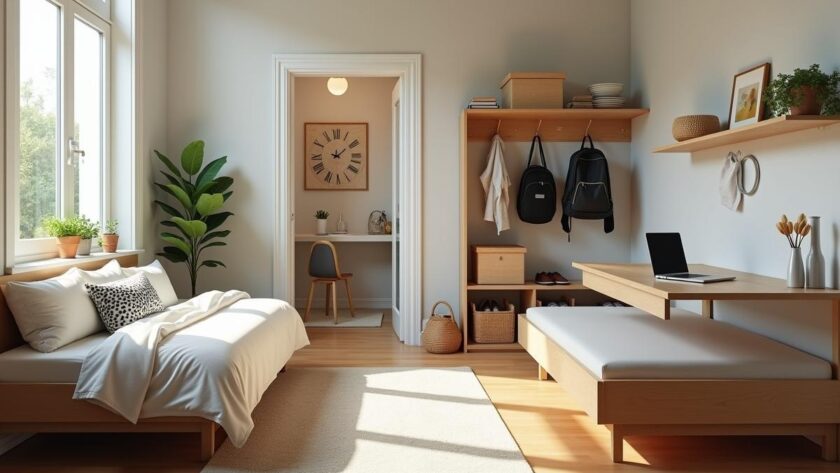Throughout life, adapt your living environment with smart storage space solutions. Regardless of your circumstances new job, bigger family, or shifting priorities the right strategies ensure your home remains organized and functional. Thinking ahead about changing demands keeps clutter at bay and makes daily life smoother. Below are practical ways to manage spaces wisely, with tips that fit specific life stages.
Contents
- 1 Early Adulthood: Space Optimization and Practical Steps
- 2 Family Life: Organization Tips for Busy Households
- 3 Adapting in Your Prime: Home Storage Ideas to Support Your Evolving Lifestyle
- 4 Retirees and Minimalists: Long-Term Storage and Beyond
- 5 Insightful Ways to Future-Proof Your Living Spaces
- 6 Practical Methods for Evolving Technology Storage
- 7 Going Forward
Early Adulthood: Space Optimization and Practical Steps
Starting out on your own often means limited room for all your belongings. This is when space optimization is crucial for creating a comfortable environment in that first apartment or studio. Multi-purpose furniture can help by doubling up on function: a bed with built-in drawers or a coffee table that flips into a desk are excellent storage solutions.
It also helps to embrace minimalism. Choose only necessary pieces and consider furniture storage if you inherit items you can’t let go of yet. Self-storage units work well for temporary storage, especially if you plan to move soon or want to keep sentimental things safe.
Digital Storage Considerations
Your first “adult” routine often includes consolidating college projects, work documents, and personal photos. Data management becomes essential to avoid losing track. You can rely on cloud storage for backup solutions and digital archiving of important files, keeping them accessible from anywhere. For those with large media libraries, disk space optimization tools or file organization software are handy to keep your laptop from overflowing.
If you’re more advanced, you might explore storage virtualization or a basic network storage setup for easy access across multiple devices. Simple capacity planning ensures reminders and updates don’t take up all your disk space. External hard drives and NAS devices offer added security while leaving enough room on your primary computer. This level of storage infrastructure helps guard against data redundancy issues and ensures storage security over time.
Family Life: Organization Tips for Busy Households
Families have growing needs, and it’s easy to accumulate everything from baby gear to sports equipment. Adopting solid organization tips helps you stay one step ahead of the chaos. Dedicated zones for different members of the household and labeled storage containers cut down on morning scramble sessions. A well-organized mudroom, for example, keeps shoes or backpacks from taking over the hall.
Consider investing in built-in cabinetry for the kitchen or living room. These give plenty of shelves for books, toys, or digital devices. Basement storage can further support your family’s changing requirements by providing a spot for out-of-season items like holiday decorations. Attic utilization is another option for stashing keepsakes or rotating clothes. Having items neatly stored away makes daily cleaning faster and reduces stress.
When more people live under one roof, small messes can quickly add up. One of the best decluttering methods is a regular “edit” of your spaces. If toys are no longer used, donate or rotate them. If clothes don’t fit, set them aside for donation or keep them in vacuum-seal bags until the next sibling can wear them.
Limit the number of items stored in shared areas to what’s in regular use. Everything else should find a spot in garage organization setups, whether that’s on a dedicated shelf or in labeled bins. This approach ensures quick retrieval while making sure your family spaces remain open and welcoming.
Adapting in Your Prime: Home Storage Ideas to Support Your Evolving Lifestyle
As your career and social life flourish, you might collect items that support new hobbies or side projects. Home storage ideas at this stage include customizing spare rooms into functional zones. A craft area, workout corner, or office nook can keep your interests organized and separate from day-to-day living. Using well-labeled storage containers for tools, art supplies, or workout accessories keeps everything accessible yet tidy.
For those managing home businesses, warehouse storage might come into play when you start carrying inventory. Inventory management systems help you track items effectively and ensure quick shipping. If you’re frequently on the go, long-term storage solutions such as furniture storage or self-storage units let you keep things safe without crowding your current living space. Combining these approaches with basic space optimization ideas ensures you remain productive.
Managing Personal Transitions
Major life events like moving to a bigger home or relocating for a new job invite a fresh look at your belongings. Moving storage options help you clear out old spaces while you focus on settling into the next. Temporary storage lets you transition smoothly through home renovations or short-term assignments in different cities. You can also combine these transitional phases with a deeper look at your electronic needs, adopting data migration strategies to keep digital content organized as you switch to upgraded devices.
When you move, do a quick capacity expansion by reorganizing your new home’s closets, pantry, or attic to accommodate the things you’ve brought along. That might include rethinking your furniture layout or building in some hidden storage compartments. A sense of flow and balance in your new environment will help you adapt more easily.
Retirees and Minimalists: Long-Term Storage and Beyond
Later in life often means downsizing or embracing a simpler approach. This stage calls for methods that focus on decluttering, preserving memories, and making daily routines more comfortable. Long-term storage can help if you own heirlooms or seasonal items but want less clutter at home. Self-storage units are still helpful for items passed down through generations that aren’t needed year-round.
For frequent travelers, warehouse storage can house an RV off-season or keep a lifetime’s collection of antiques safe. If you’re consolidating decades of paperwork, file storage solutions assist in archiving documents you can’t simply discard. Coupled with digital archiving, you can reduce paper piles and maintain easy access.
Eco-Friendly Storage Choices
Going green appeals to many people looking for more sustainable living. Eco-friendly storage might include bamboo shelving for its durability, or linen bins for breathability. You could also look into recycling and repurposing items rather than buying brand-new. Outdoor storage options built from upcycled wood or composite materials allow gardeners to keep tools in an environmentally conscious shed.
Digital clutter can also play a role here. Embracing storage efficiency reduces your electronic waste over time and makes the most of what you already own. You could repurpose an older solid state drive into simpler tasks such as backups. Deduplication software keeps multiple copies of files from eating up precious storage capacity. This approach lowers the demand for brand-new parts and helps the planet.
Insightful Ways to Future-Proof Your Living Spaces
It’s easy to get swept up in everyday obligations, yet planning ahead saves you from frantic last-minute scrambling. Look at corners you haven’t evaluated in a while such as basement storage or attic utilization and check if they can be rearranged for maximum benefit. Small improvements like installing extra shelves or using stackable storage containers keep your essentials within reach.
If you’re a bit tech-savvy, network storage could unify all your smart devices and let your family access photos, documents, or media from a central location. RAID systems afford data redundancy, ensuring your most valuable files stay safe, even in the event of a drive failure. With storage virtualization, you might merge multiple drives into one flexible storage pool. This helps with capacity planning if you foresee an increase in your digital collection.
Embracing Adaptable Furniture and Layouts
Furniture that can transform based on your current needs is highly valuable in any stage of life. Sofas that convert to beds or desks that fold into walls save space and give you more room for everyday activities. This philosophy extends to outdoor storage options where sheds or cabinets can be adjusted seasonally.
When you notice your possessions outgrowing your living space, it’s time to consider additional solutions, like a self-storage unit or a dedicated storage room. If you suspect a shorter-term need, focus on temporary storage arrangements. If items will remain away for years, look at options that emphasize security and climate control, especially for sensitive goods. This balance between flexibility and protection keeps everything in prime condition.
Practical Methods for Evolving Technology Storage
Modern life involves more than just physical belongings. Our digital footprints also grow over time. File organization remains key to locating crucial documents or sentimental photos. You can rely on external hard drives, particularly if you don’t trust online providers, as they offer direct control over your data. However, always keep backups to avoid data loss.
Storage efficiency improves with deduplication, which identifies repeated files and keeps only a single version. Solid state drives run faster than older HDDs, so tasks like data migration or capacity expansion become easier. Also, make sure to keep an eye on storage security. Whether through reputable cloud services or a NAS device locked with strong credentials, safeguarding personal data protects against unexpected breaches.
Going Forward
Housing needs change with each chapter of life. From the simplest studio to a sprawling family home, mindful planning keeps your property tidy and adaptable. Whether it’s garage organization for sports gear, attic utilization for seldom-used winter coats, or a small corner devoted to data management, every space can be optimized.
Look at where you can use partial solutions maybe a corner shelf or a set of stackable storage containers to gain more breathing room. If your schedule fills up, consider a self-storage unit or warehouse storage to tuck away seasonal items. Tools like backup solutions and digital archiving can reduce paper clutter, and investing in capacity planning ensures you never run out of room on your devices. By combining physical and digital storage strategies, you’ll create an environment that meets your needs at every turn.




